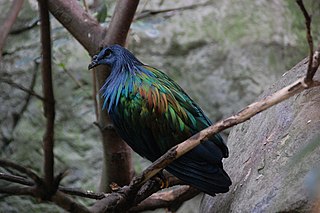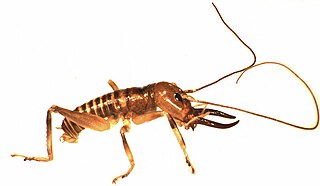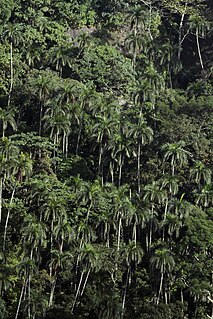Related Research Articles

The Nicobar pigeon is a bird found on small islands and in coastal regions from the Andaman and Nicobar Islands, India, east through the Malay Archipelago, to the Solomons and Palau. It is the only living member of the genus Caloenas, and may be the closest living relative of the extinct dodo, as well as the extinct Rodrigues solitaire.

The Nicobar Islands rain forests is a tropical moist broadleaf forest ecoregion in the Nicobar Islands. The Nicobar Islands are in the Indian Ocean, lying north of Sumatra and south of the Andaman Islands. The islands are politically part of India, although physically closer to Southeast Asia. Millions of years of isolation from the mainland has given rise to a distinct flora and fauna, including many endemic species.

The Northland tusked wētā, Anisoura nicobarica, is a rare monotypic wētā of the family Anostostomatidae, endemic to the northern half of Northland in New Zealand, and originally described in 1932. The type specimen was wrongly labelled as coming from the Nicobar Islands, so the species was named Anisoura nicobarica. It was erroneously described again in 1950 by a different author, who placed it in the ground wētā genus Hemiandrus.

Bentinckia is a genus of palms in the family Arecaceae. The genus is named after William Henry Cavendish-Bentinck a colonial governor general of British India. There are two species of palms in this genus. namely Bentinckia condapanna and Bentinckia nicobarica.

Bentinckia nicobarica is a species of flowering plant in the family Arecaceae found to occur in the Nicobar group of islands in the Bay of Bengal. It is an endemic palm occurring in Great Nicobar, Katchal, Nancowry and Car Nicobar Islands.

The Nicobar treeshrew is a treeshrew species within the Tupaiidae. It is endemic to the Nicobar Islands where it inhabits the islands' rain forests. It is threatened by habitat loss.

The Nicobar shrew or Nicobar white-tailed shrew is a critically endangered species of mammal in the family Soricidae. It is endemic to the Great Nicobar Island of India.
Mangifera nicobarica is a species of plant in the family Anacardiaceae. It is endemic to the Nicobar Islands.

Cethosia biblis, the red lacewing, is a species of heliconiine butterfly belonging to the family Nymphalidae.
Hierodula nicobarica is a species of praying mantis in the family Mantidae.
Marmaroglypha is a genus of longhorn beetles of the subfamily Lamiinae, containing the following species:
Pleurobranchella is a genus of sea slugs, marine gastropod mollusks in the family Pleurobranchaeidae.
Momisis nicobarica is a species of beetle in the family Cerambycidae. It was described by Gardner in 1936. It is known from the Nicobar Islands.

Marmaroglypha pubescens is a species of beetle in the family Cerambycidae. It was described by Per Olof Christopher Aurivillius in 1898 and is known from the Philippines.
Marmaroglypha densepunctata is a species of beetle in the family Cerambycidae. It was described by Stephan von Breuning in 1948. It is known from Malaysia and Borneo.
Marmaroglypha fasciata is a species of beetle in the family Cerambycidae. It was described by Francis Polkinghorne Pascoe in 1869. It is known from Borneo and Malaysia.
Marmaroglypha sumatrana is a species of beetle in the family Cerambycidae. It was described by Ritsema in 1888. It is known from Sumatra.
Marmaroglypha vermiculata is a species of beetle in the family Cerambycidae. It was described by Stephan von Breuning in 1948. It is known from Borneo and Indonesia.
Serixia nicobarica is a species of beetle in the family Cerambycidae. It was described by Stephan von Breuning in 1958.
References
- ↑ BioLib.cz - Marmaroglypha nicobarica. Retrieved on 8 September 2014.